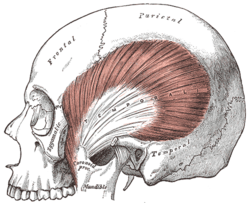Structure and Development
- Arises from the temporal fossa and deep part of temporal fascia
- Passes medial to the zygomatic arch
- Inserts onto the coronoid process of the mandible
- Covered by the temporal fascia
- Accessible on the temples and can be seen and felt contracting
- Derived from the first pharyngeal arch in development
- Has a complex structure
- Sarcomeres are a consistent length
- Larger muscle fibers vary in length within the muscle and between individuals
Blood and Nerve Supply
- Receives blood supply from the deep temporal arteries
- Anastomoses with the middle temporal artery
- Controlled by the third branch of the trigeminal nerve
- Supplied by the deep temporal nerves
- At least 6 smaller branches recruit muscle fibers
- Recruitment of motor units maximizes contractile strength
Function
- Most powerful muscle of the temporomandibular joint
- Can be divided into anterior and posterior parts
- Anterior portion elevates the mandible (closing the mouth)
- Posterior portion retrudes the mandible
- Middle portion used for both elevation and retraction, as well as lateral movement of the mandible
Clinical Significance
- Involved in jaw pain and headaches
- Overwork of the temporalis muscle can result in pain
- Bruxism and jaw clenching can lead to temporalis muscle overuse
- Myotendinous rupture of the temporalis muscle can occur during a seizure
- Extreme clenching of the jaw during a seizure can cause the rupture
- Temporalis muscle may be used in reconstructive surgery of the mouth
- Incisions during pterional craniotomy are chosen based on ease of reattaching the temporalis muscle
Additional Information
- Temporal muscle (red)
- Muscles of head and neck
- Deep dissection of temporal muscle
- Mummification process
- References to relevant studies and publications
In anatomy, the temporalis muscle, also known as the temporal muscle, is one of the muscles of mastication (chewing). It is a broad, fan-shaped convergent muscle on each side of the head that fills the temporal fossa, superior to the zygomatic arch so it covers much of the temporal bone.Temporal refers to the head's temples.
| Temporalis muscle | |
|---|---|
 The temporalis muscle; the zygomatic arch and masseter have been removed. | |
| Details | |
| Origin | temporal lines on the parietal bone of the skull and the superior temporal surface of the sphenoid bone |
| Insertion | coronoid process of the mandible and retromolar fossa |
| Artery | deep temporal arteries |
| Nerve | deep temporal nerves, branches of the anterior division of the mandibular nerve (V3) |
| Actions | elevation and retraction of mandible |
| Antagonist | platysma muscle |
| Identifiers | |
| Latin | Musculus temporalis |
| MeSH | D013703 |
| TA98 | A04.1.04.005 |
| TA2 | 2108 |
| FMA | 49006 |
| Anatomical terms of muscle | |